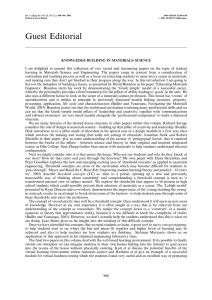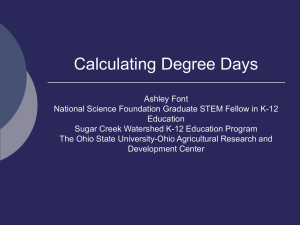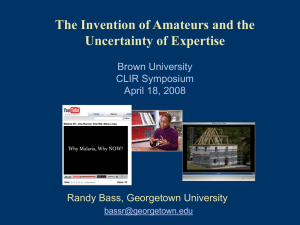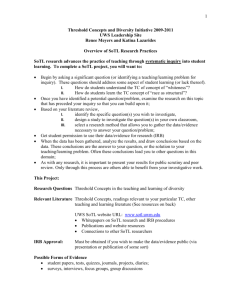Int. J. Engng Ed. Vol. 22, No. 5, pp. 955±962,... 0949-149X/91 $3.00+0.00 Printed in Great Britain. # 2006 TEMPUS Publications.
advertisement
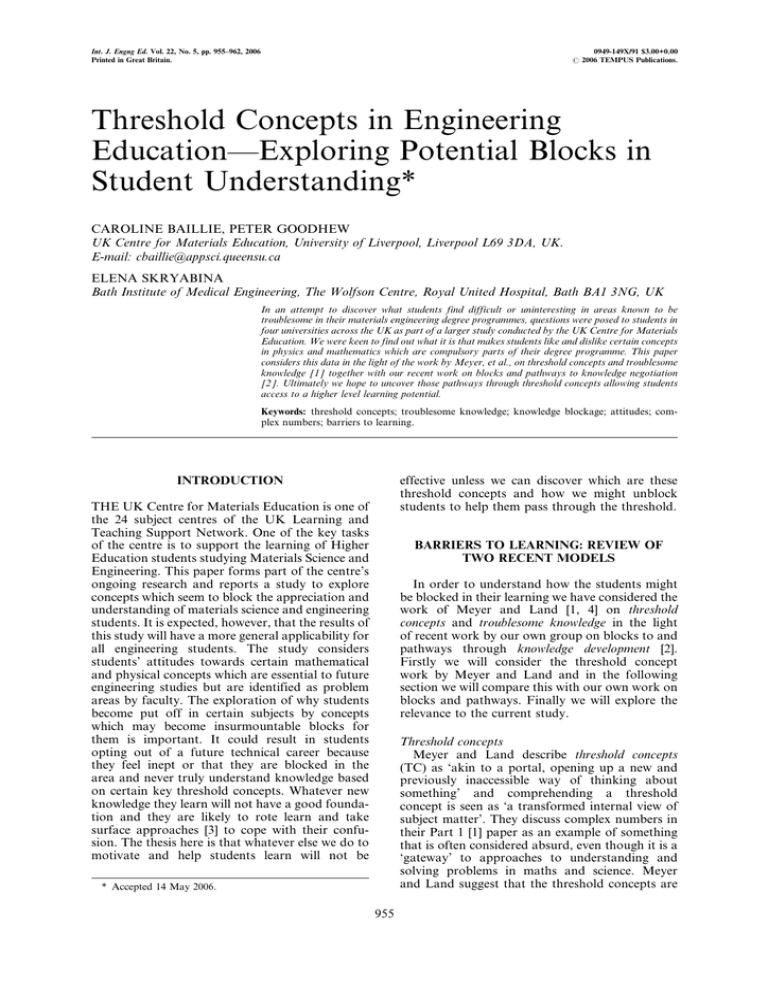
Int. J. Engng Ed. Vol. 22, No. 5, pp. 955±962, 2006 Printed in Great Britain. 0949-149X/91 $3.00+0.00 # 2006 TEMPUS Publications. Threshold Concepts in Engineering EducationÐExploring Potential Blocks in Student Understanding* CAROLINE BAILLIE, PETER GOODHEW UK Centre for Materials Education, University of Liverpool, Liverpool L69 3DA, UK. E-mail: cbaillie@appsci.queensu.ca ELENA SKRYABINA Bath Institute of Medical Engineering, The Wolfson Centre, Royal United Hospital, Bath BA1 3NG, UK In an attempt to discover what students find difficult or uninteresting in areas known to be troublesome in their materials engineering degree programmes, questions were posed to students in four universities across the UK as part of a larger study conducted by the UK Centre for Materials Education. We were keen to find out what it is that makes students like and dislike certain concepts in physics and mathematics which are compulsory parts of their degree programme. This paper considers this data in the light of the work by Meyer, et al., on threshold concepts and troublesome knowledge [1] together with our recent work on blocks and pathways to knowledge negotiation [2]. Ultimately we hope to uncover those pathways through threshold concepts allowing students access to a higher level learning potential. Keywords: threshold concepts; troublesome knowledge; knowledge blockage; attitudes; complex numbers; barriers to learning. effective unless we can discover which are these threshold concepts and how we might unblock students to help them pass through the threshold. INTRODUCTION THE UK Centre for Materials Education is one of the 24 subject centres of the UK Learning and Teaching Support Network. One of the key tasks of the centre is to support the learning of Higher Education students studying Materials Science and Engineering. This paper forms part of the centre's ongoing research and reports a study to explore concepts which seem to block the appreciation and understanding of materials science and engineering students. It is expected, however, that the results of this study will have a more general applicability for all engineering students. The study considers students' attitudes towards certain mathematical and physical concepts which are essential to future engineering studies but are identified as problem areas by faculty. The exploration of why students become put off in certain subjects by concepts which may become insurmountable blocks for them is important. It could result in students opting out of a future technical career because they feel inept or that they are blocked in the area and never truly understand knowledge based on certain key threshold concepts. Whatever new knowledge they learn will not have a good foundation and they are likely to rote learn and take surface approaches [3] to cope with their confusion. The thesis here is that whatever else we do to motivate and help students learn will not be BARRIERS TO LEARNING: REVIEW OF TWO RECENT MODELS In order to understand how the students might be blocked in their learning we have considered the work of Meyer and Land [1, 4] on threshold concepts and troublesome knowledge in the light of recent work by our own group on blocks to and pathways through knowledge development [2]. Firstly we will consider the threshold concept work by Meyer and Land and in the following section we will compare this with our own work on blocks and pathways. Finally we will explore the relevance to the current study. Threshold concepts Meyer and Land describe threshold concepts (TC) as `akin to a portal, opening up a new and previously inaccessible way of thinking about something' and comprehending a threshold concept is seen as `a transformed internal view of subject matter'. They discuss complex numbers in their Part 1 [1] paper as an example of something that is often considered absurd, even though it is a `gateway' to approaches to understanding and solving problems in maths and science. Meyer and Land suggest that the threshold concepts are * Accepted 14 May 2006. 955 956 C. Baillie et al. likely to be transformative i.e. that they mark a shift in the perception of the subject by the student, irreversible, integrative, bounded and troublesome. This latter refers to Perkin's troublesome knowledge (TK) [5]. Meyer and Land suggest that where difficulties exist, the learners may be left in a state of liminality (Latin `limen'Ða threshold). Liminality may refer to an individual or a groupÐa suspended state in which understanding approximates to a kind of mimicry. The transition is problematic, troubling and often humbling, and students often mimic the new status without understanding the meaning of what they are doing. They may oscillate back and forth but once entered the student cannot return to the pre-liminal state. This is compared by Meyer and Land to cultural initiations or to adolescence, however in education as with other contexts, it is clear that students may not reach the transformed status and become stuck. Thus we could understand dysfunctional development of a child who does not enter adulthood is similar to the dysfunctional learning of a student who attempts to mimic the conceptual understanding and may have some preliminary grasp but is only interested in reproduction (i.e. as with the `surface approaches' described earlier). Further exploration of the reasons for student difficulties are given by Perkins [5] and Meyer and Land [1] as: 1. Ritual knowledgeÐof routine and rather meaningless character such as following procedures in arithmetic. In an attempt to make a concept seem more understandable, teachers sometimes create a naõÈve version of the concept and students enter into a form of ritualised learning or mimicry. When the students show no signs of understanding the concept teachers simply ask them to do more of the same. This can seem very dull to students who often describe learning in these areas as boring. 2. Inert knowledgeÐnot integrative nor seemingly related to real life. Integration is troublesome because students need the `bits' before they can be integrated but after this they need to be persuaded to see the whole in a new way. Hence often new knowledge remains as disconnected pieces which are therefore void of life. 3. Conceptually difficultÐwhat we often notice as teachers is that in an attempt to learn difficult concepts, students mix scientistic views of the concept with their own misconceptionsÐhence a mix of ritual knowledge with misconceptions. Often the intuitive belief resurfaces in any other context than the exam room. 4. Alien knowledgeÐknowledge can often be counter intuitive, e.g. the notion of objects in motion, asking students whether heavier objects will fall at the same rate as lighter ones will often result in confusion. Many of these categories can overlap of course, in that alien knowledge is also conceptually difficult and so on. 5. Tacit knowledgeÐunderstandings are often shared between a community of practice but not often explained or exposed e.g. a person coming into a new community or country may not pick up the nuances of different concepts which are `common sense' to the old-timers. This is an important area of knowledge development if identified by teachers in advance. 6. Troublesome languageÐdiscourses have developed within disciplines to represent ways of seeingÐbut these can be troublesome for the newcomer especially if the words have a common usage as well e.g. `elasticity'. The problem we have is that no concepts can exist outside the system of thought and language. It is entirely possible that a concept can be understood on one way in one country (or discipline, etc.) and very differently in another for this reason. Knowledge development Comparing this approach to student learning with our own previous work on knowledge negotiation we see many parallels. We have explored blocks which seemed to prevent knowledge development between any two people (who may be both learners or teachers) from taking place [2, 6]. These may be summarised as follows and details given in the full references: 1. Thought collectives. For something to be known it must fit within the paradigm or thought collective of that community. 2. Blinkered perceptionÐassumptions, tacit knowledge. We all have blinkers (by analogy with the leather shields placed over horses eyes so that they only see the road ahead)Ðwhich are set up by social, psychological and cultural factors. 3. Negative environment. There are many factors influencing the physical environment in which one is either aided or barred from creating knowledge [7]. 4. Belief system. Beliefs are important because they form the cognitive system of an individual. Beliefs can be formed through a direct experience and through an indirect experience. It is a strong tendency for people to keep their beliefs thus maintaining the balance and harmony between elements of his/her cognitive system. It is extremely difficult for someone to know something when their belief system opposes the knowledge but in cases where people feel the need to rebel against that belief, they become just as single minded for a different purpose. Comparing the above frameworks we can see that the trouble spots of alien knowledge and tacit knowledge have similarities with what we call blinkered perception, thought collectives and belief systems. PATHWAYS THROUGH THE BARRIERS In our previous work on knowledge building we also noted several ways in which we can aid the knowledge building process: Threshold Concepts in Engineering Education 957 1. Attitude: humility, empathy, interest, past experience. It is known in many different areas of communication theory and psychotherapy that humility, empathy and interest are necessary for learning. It is not possible to gain new knowledge if you believe that you know it all already or that you do not need the new knowledge because of its perceived irrelevance or lack of obvious applicability, or because you do not want to bring back the unhappy past experience associated with this knowledge. Our beliefs are very important (this is how attitudes are formed through the cognitive way), however emotions and feelings are as important as beliefs (this is an affective way of attitude formation) as well as our past experience (behavioural way of attitude formation). It happens quite often when a learner may rebel (intrinsically) against gaining new knowledge due to unpleasant or unhappy associations and emotions generated by his/her past or present learning experience. 2. Conversation: refutations, questions, avoiding avoidances. Attitude is very important but is obviously not enough, as a passive recipient can never build knowledge with another person. Feedback is imperative but it is not simply a case of repeating back the knowledge `given' to them. 2. Differentiating. It is also possible to recognise that knowledge building has taken place when the learner becomes aware of a new depth in what originally appeared to be superficial. 3. Inclusive value systems. Evidence of the emergence of new knowledge with an appreciation of personal values indicates understanding. 4. Identification of basic conceptsÐnot caricatures. Knowledge expressed clearly through identification of basic concepts indicates knowledge building in a way which knowledge of concepts hidden beneath jargon and theories cannot. 5. Euphoria. Maslow's `peak' experience, that euphoria we feel on truly understanding something for the first time, when the `light bulb turns on', is the most evident proof of knowledge building. Finally we considered how we might recognise that knowledge negotiation or learning (when it) had taken place. In Meyer and Lands' terms, how would we know a student has passed through the threshold? What evidence do we have that any knowledge building has taken place? The following categories are ways in which it is possible during the conversation to notice that knowledge building of come kind is occurring, that some learning is taking place. The following ways were discovered and although these have not yet been translated into assessment practices we might start to consider how these could be implemented: The overall survey was conducted by means of interviews and questionnaires with members of teaching staff and students from four UK universities. Initial data relating to the identification of problem areas for students was elicited from the staff interviews but the major part of this study relates to the student surveys. 250 students from 4 universities (designated `A', `B', `C' and `D') in the UK participated in the survey. These numbers are distributed across the universities and departments in ways shown in Table 1. We will focus in this paper on the responses to a subset of the questions in the questionnaire (see appendix) which asked the students about their attitudes towards studying different topics from the two subjects Mechanics and Mathematics and beliefs underlying these attitudes. Five concepts from Mechanics (Physics) and five concepts from Mathematics were selected, all of which had been 1. Thinking about knowing. It is one thing to question someone and ask for feedback but another to question ourselves. We can observe the occurrence of thinking which involves self reflection about the new knowledge. We can see many overlaps between the two approaches given above. It is not so important that we have the inclusive set of all possible blocks but that we can identify such blocks for our own students and find the pathway through. We are obviously interested in the `unsticking' of studentsÐof helping them pass through the threshold. METHODOLOGY Table 1. Students participating in the study University A A B C C C D D D D D Degree subject Abbreviation Numbers Materials Science Aerospace Engineering Sport Engineering and Technology Mechanical Engineering Aeronautical Engineering Chemical Enginering Mechanical Engineering Aerospace Engineering Integrated Engineering Chemistry Biomaterials and Materials Mat AE SEn ME AE* CE ME AE InE Ch BioM 24 47 10 42 12 11 40 33 12 11 8 958 C. Baillie et al. Table 2. Main reasons for a concept to be identified as `least favourite'. The data are presented as numbers of responses. For abbreviations see Table 1. `M' means Mathematics and `P' means Physics. Reasons University A Mat Difficulty Boredom Irrelevance University B AE SEn M P M P M 6 3 5 2 1 3 2 2 4 1 4 University C ME P M AE* P 14 4 1 M 2 3 identified by faculty as being problem areas for students. RESULTS AND DISCUSSION Least interesting concepts The overall results indicated that students' attitudes towards doing Mechanics were significantly Table 3. Student's verbatim responsesÐreasons for a concept being identified as `least interesting'. Only reasons, which attracted more than 20 responses are included. Difficulty of a topic (58 responses). Typical responses are: . . . . . . . It is difficult Hard to understand Don't understand Complex and hard Hard to understand 1st time There are so many rules to remember Hard concept to understand: . Boredom of a topic (36 responses). Typical responses are:: . . . . . . . . . . . Very boring Repetitive Take too long for a minimum useful outcome, Most tedious Monotonous Very boringÐthey are all the same and not very enjoyable Involves long calculations which are extremely boring Dull and repetitive A lot of trivial reading required Time consuming and not very useful Very boring, covered in a levels: . Irrelevance of a topic (50 responses). Typical responses are:: . They are not applied to anything so seem pointless . It is not real (i.e. Doesn't exist). What the point in learning it? . They can only be used in abstract situations . Seems inappropriate to life in general . Can't relate them to anything, actually happening around you . I find it is not in the real world . Fail to see relevance in day to day tasks . It has little relation to real life . I have never had to put them into practice with something from real life . Not too useful, can't see how it can be applied to much effects in practical situations . It is hard to think where you may use it . I think it is the least relevant to my course . Seems irrelevant with engineering . Unneeded for aerospace applications . No relevance to engineering . Seems pointless CE P University D BioM M P M 5 1 1 2 2 1 4 P ME AE Ch InE M P M P M P M 8 3 3 1 11 4 4 1 1 1 1 1 1 3 1 2 P more positive than attitudes towards doing Mathematics. In analyses of students' responses towards the least interesting subject to study (question 3 in the appendix) the following picture has emerged. Only reasons which attracted more than 20 responses are included in Table 2. It can be clearly seen from the Table 2 that the vast majority of topics marked as `least interesting' to students were from Mathematics. From a general analyses of students' free text responses on reasons for a concept being perceived as `least interesting' (see question 3 of questionnaire example in appendix) the following picture has emerged (Table 3). Five concepts from first year Mathematics modules of Engineering Degree programmes were selected and offered to students for evaluation (see example of the questionnaire in the appendix). These concepts were the following: differentiation and integration (diff.+integr.), polynomials, binomial expansion (binom. exp.), complex numbers (complex N.) and vectors and matrices (vectors+matr.). The distribution of students' responses for least interesting concept from Maths gave rise to the picture in Fig. 1. It can be seen that `complex numbers' turned out to be the least interesting concept to study out of five suggested. Typical responses for this were those given in Table 4 (34 responses). Analysing students' responses it turned out that problems associated with complex numbers were mostly because of their: . perceived difficulty (16 responses) . boredom (2 response) . irrelevance for a degree (15 responses). The most interesting concept Out of the ten options suggested (five from Mathematics and five from Mechanics) only five were selected more often than the others as the most interesting topic (Fig. 2). Students seemed had difficulty in selecting the most interesting topic to study out of suggested ones. It is interesting to point that for some students studying `complex numbers' were found to be more interesting then studying `direct stress and strain', `kinetic and potential energy' or `momentum and impulse'. The reasons for considering a certain concept as Threshold Concepts in Engineering Education 959 Fig. 1. Least interesting concepts in mathematics. Table 4. Some of the student's responsesÐreasons stated for complex numbers to be the least interesting concept in Maths. . I find it hard to understand pure maths and end up never use it again . Difficult to understand and relate to real world . Don't see sense in it . Hard . Uninteresting . Too complicated . Least useful . Difficult to understand . Can't understand relevance . Don't understand them . Doesn't seem high relevance in Mechanical Engineering . Too hard . Not too useful, can't see how it can be applied to much effect in practical situations . Pointless outcome . It is not real (i.e. Doesn't exist). What the point in learning it? . It blows my mind . New and boring Table 5. Student's responsesÐreasons stated for Newton's Laws being the most interesting concept out of ten concepts suggested . . . . . . . . . . . It is applicable in real situations + can be imagined I like to know how and why things work Because of the applied side of things Applies to a lot of aspects (to everything) of/in engineering They show how things in the real world work as a basic level They explain most physics Easy to put into an everyday context Everything moves, the study of dynamics of moment is fascinating They explain many everyday occurrences They relate to real things They are most interesting as it is easy to see their effect in life being the most interesting to study were those given in Fig. 3. Looking at Figs 2 and 3 it can be seen that the most quoted area was `Newton's Laws' and the main reason behind it was the big spectrum of applicability of Newton's Laws to practical and Table 6. Student's responsesÐreasons stated for complex numbers being the most interesting concept out of ten suggested . This is a new concept from A-level . They are weird + abstract and you have to think instead of being just a calculator . I am simply interested in the complex number systems . I find imaginary numbers fascinating . Like to experience new and interesting mathematical scenario . Something to amuse your mates when you down to pub . Application in EE100 course . I enjoy it basically . Up to date, I have been enjoying it and I think the lecturer is doing a great job and I am even using it in circuits . There is so much you can accomplish with them . New and unique area of Math which has applications (in electronics) everyday situations. Typical responses of students explaining their positive attitudes towards studying Newton's Laws just confirm it (Table 5). The reasons for considering complex numbers as the `most interesting' topics to study out of suggested ones are given in Table 6. Novelty and again, a wide spectrum of perceived applicability are two main reasons for `liking' complex numbers. The threshold for understanding complex numbers In this work we are making the assumption that by asking the question about what students find interesting, we will unearth some of the blocks to understanding or passing through the threshold. It appears that the issues or blocks to the threshold for complex numbers range along three dimensions of variation for students from: . routineÐnovel . irrelevantÐapplicable . difficultÐunderstandable. One group of students in the study seemed to feel that studying complex numbers is routine, i.e. that 960 C. Baillie et al. Fig. 2. Most interesting concept to study out of ten suggested. Fig. 3. Reasons for a concept being considered most interesting to study. they had to follow standard procedures for the sake of passing the test, and that they were irrelevantÐnot useful to them nor could they see the relevance to their studies or employment and that they were difficult to understand. The other group seemed to believe that complex numbers are very novel, that they are in fact very applicable to their studies and that they are understandable. We could therefore imagine that students who have passed through the threshold might say that they find complex numbers novel, interesting, applicable and understandable. Those that are stuck will say the opposite. The focus of our attention therefore needs to be on how to shift from left to right along these dimensions. It is of course not enough to tell students how novel, applicable or easy to understand these concepts are, which is one of the most tempting ways to deal with knowledge of this sort. Meyer and Land [4] describe processes by which teachers might explore and advance their own reflective practice on teaching. They warn that the way threshold concepts are introduced can be very important. As described above, teachers making an effort to simplify the concept can sometimes inadvertently develop naõÈve interpretations, ritualised knowledge, in a sort of mimicry of what students believe we wantÐthis may indeed be what has caused the `boredom' category discussed here. These dimensions of variation relate to the Meyer and Land's barriers to learning as follows: . routineÐritual knowledge . irrelevantÐinert knowledge . difficultÐconceptually difficult or alien knowledge Perceived difficulty could relate to the Meyer and Land's categories of `conceptually difficult' or `alien knowledge'. The category of boredom could indicate that students have perhaps been subjected to a ritualised form of knowledge by the teacher in an attempt to help them understand (or because of the teachers' own limitations in understanding). Irrelevance seems to relate to the notion of inert knowledge discussed aboveÐdead and unrelated to other concepts or to the real world. Not only do we see that there is evidence of students feeling very differently after they have passed through the threshold, but that the sorts of things they are saying about their experiences on the `dark side' are similar to those categories expressed by Meyer and Land, in their work which has been derived from a variety of other disciplines. Threshold Concepts in Engineering Education SUMMARYÐPATHWAYS THROUGH THE THRESHOLD We have explored the notion of threshold concepts in two areas of engineering curricula and have focussed on `complex numbers' as one concept which students can find particularly difficult. We have studied the responses of students who appear to have passed through the threshold and those that have not yet done so. But how might we help students move through the threshold or barrier to learning, what pathway can they seek? If we reflect on the work presented above on pathways to knowledge development, we might imagine that in order to aid students' passage of learning, we could help students enter into dialogue with each other to share their conceptions of, in this case, complex numbers, i.e. expose variation in students' learning. Meyer and Land remind us that if we understand student-centred teaching to require sensitisation to variation within student learning then we can understand this in a more specific way if we develop awareness of the threshold concepts in a discipline and the way in which students respond to these. In this paper we are exploring concepts which are characteristically known to be difficult for students to see if the variation in the way in which they describe their problems can shed some 961 light on the teaching of these concepts, and by trying to identify pathways through the barriers. Students will become aware of their own tacit knowledge and blinkered perception by seeing through the eyes of others, seeing their misconceptions and confusions and by beginning to address what seems alien. Students will be able to see others' perspectives and compare these with their ownÐ thus making it all seem more familiar territory. In conversation with each other they may develop an `outcome space' [2] of all possible correct conceptions in the class as well as students and teacher being able to correct each other's misconceptions. This would deepen their understanding of the concept and prevent the ritualisation and simplification which may be detrimental to the level of interest and engagement that a student can muster. It will also help the concept to `live' and avoid the inert nature of unused knowledge. Further exploration of the variation in students' experience of threshold concepts such as complex numbers certainly needs to be carried out. We might then also design our classes in such a way as to help students explore more fully the depth of the concept and expose typical misconceptions. In the meantime as teachers we might reflect upon perceived threshold concepts in our own area and our students' various ways of understanding these, in an attempt to unravel ways of helping more students pass through those gateways. REFERENCES 1. J. Meyer and R. Land, Threshold concepts and troublesome knowledge (1) linkages to ways of thinking and practising within the disciplines, in C. Rust (ed.) Improving Student Learning Theory and PracticeÐ10 Years On, OCSLD, Oxford (2003) pp. 412±424. 2. C. Baillie, Negotiating Scientific Knowledge in Entangled Histories and Negotiated Universals: Centres and Peripheries in a Changing World, Campus Verlag, Berlin (2002) pp. 32±57. 3. P. Ramsden, Learning to Teach in Higher Education, Routledge Falmer (1992). 4. J. Meyer, and R. Land, Threshold concepts and troublesome knowledge (2): epistemological and ontological considerations and a conceptual framework for teaching and learning, 10th Conf. EARLI, Padova, Italy, Aug 2003. 5. D. Perkins, The many faces of constructivism, Educational Leadership, 57(3) 1999, pp. 6±11. 6. C. Rose and C. Baillie, Travelling Facts in Travelling Facts: The Social Construction, Distribution and Accumulation of Knowledge, C. Baillie, E. Dunn, Y. Zheng, (eds) Campus Verlag (2004) pp. 17±27. 7. S. Dewulf and C. Baillie, CASE: Creativity in Art, Science and Engineering, DfEE (1999). 8. J. Bowden and F. Marton, The University of Learning, Prentice-Hall (1998). 962 C. Baillie et al. APPENDIX 1 Extract of questions in the ukcme questionnaire relating to this study. 1. The next part of this questionnaire asks you to indicate your attitudes towards certain subject areas. Please mark in the boxes using a scale of 1±5 where: 5 means agree; 4 agree somewhat; 2 disagree ; 1 strongly disagree Try not to use 3 unsure; unless you really have to. Mechanics Subject area Interesting Useful Enjoyable Interesting Useful Enjoyable Newton's Laws Work and Force Kinetic and Potential Energy Direct Stress and Strain Momentum and Impulse Mathematics Subject area Differentiation and Integration Polynomials Binominal Expansions Complex Numbers Vectors and Matrices 2. Which of the above concepts is the MOST interesting to you and why? ________________________________________________________________________________________ ________________________________________________________________________________________ ________________________________________________________________________________________ 3. Which of the above concepts is the LEAST interesting to you and why? ________________________________________________________________________________________ ________________________________________________________________________________________ ________________________________________________________________________________________ Caroline Baillie is a Professor of Materials Engineering within the Chemical Engineering Dept. at Queens University, Kingston, Ontario. Her research interests in materials science have developed from a background in composite materials (reinforced plastics) to a focus on natural sustainable composites and biomimicry. She is particularly interested in ways in which science and engineering can help to create solutions for the environment as well as social problems. She has over 100 publications in materials science and education and is the author of several books including a Woodhead publication Green Composites, 2004 and a Routlegde Falmer publication Effective Learning and Teaching in Engineering, 2004.

